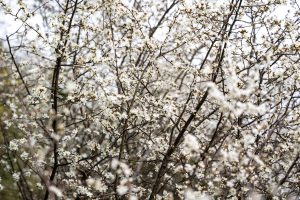In praise of the Sparrowhawk
From views we’ve heard over the years from our customers and from elsewhere, it’s probably fair to say that if there’s one bird that frequently visits our gardens which divides opinion, it’s the Sparrowhawk. For some, it’s the cause of excitement and wonder as it makes commando-style raids at lightening-speed to pluck an unsuspecting Greenfinch off a seed feeder, and for others it’s the cause of anger and distress for doing just the same thing.
But let’s pause for a moment and consider just what’s happening here. The Sparrowhawk, like the Greenfinch, is just trying to earn a living and, at this time of year, has young to feed. In fact, and this is interesting, the Sparrowhawk’s chicks hatch at just the point when there are plenty of fledgling songbirds around – so in early June. The Greenfinch will be feeding its fledglings invertebrates and, quite probably, the seed you put out in feeders. The Sparrowhawk’s young are yet to fledge, but being fed in the nest with meat from both adult and fledgling Greenfinches – and of course a wide variety of other songbirds, from relatively small Blue Tits to something as a large as Blackbird (though only the larger female Sparrowhawk would normally attempt the latter).
Many centuries ago and in a landscape of plentiful mature woodland and minimal urbanisation, all of this would have been going on unseen and in an entirely natural way. But the UK isn’t like that anymore, and the vast majority of us live in a man-made landscape and one where acres of ancient woodland once stood. The Sparrowhawk, which has been recovering from a population crash in the 50s and 60s, doesn’t know about any of this and just sees the mosaic of gardens as the same sort of hunting territory it would have in ancient times. Although now, it has the added benefit of us feeding songbirds – which we’re partly doing to in our gardens to compensate for lack of natural food due to that urbanisation – and no doubt this has aided its recovery.
We’ve often heard concerns that Sparrowhawks are responsible for declines in songbird numbers, but the fact is that long-term scientific studies show they have little or no effect on them. This is largely because songbirds have evolved to have large numbers of young – on average 15 in a season – and in the absence of a top predator like the Sparrowhawk, many of these would die anyway. It’s just a fact of life, and if that wasn’t case then imagine for a moment what would happen if all 15 young songbirds survived and bred the following year: We’d be knee-deep in songbirds!
So, Sparrowhawks are now an established part of our man-made ‘garden food chain’, and we therefore encourage everyone to embrace them, and enjoy the spectacle in your garden of this truly impressive bird of prey, as it makes almost unbelievable acrobatic manoeuvres in flight to capture the next meal for its offspring.


